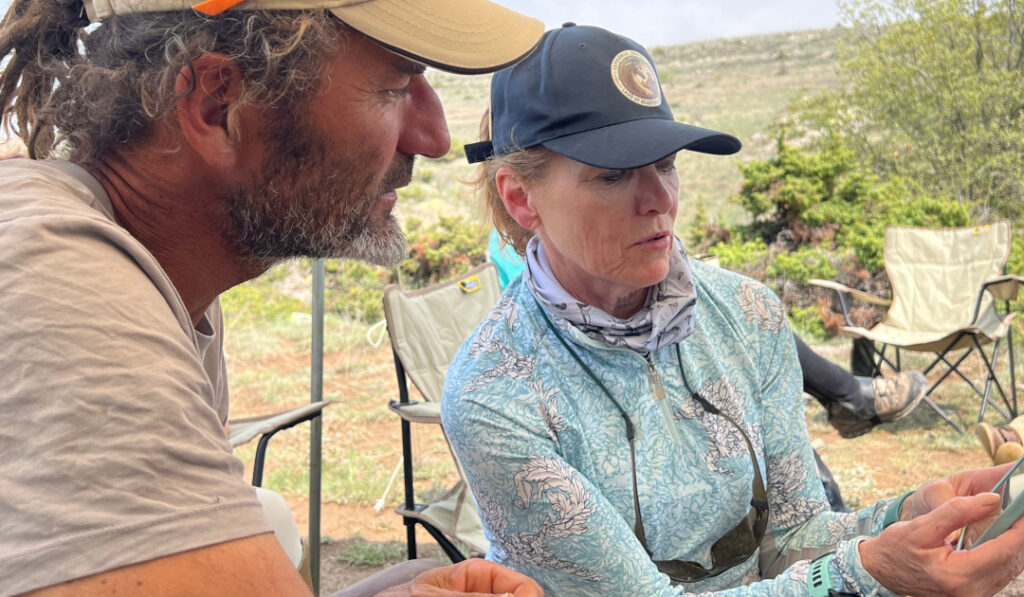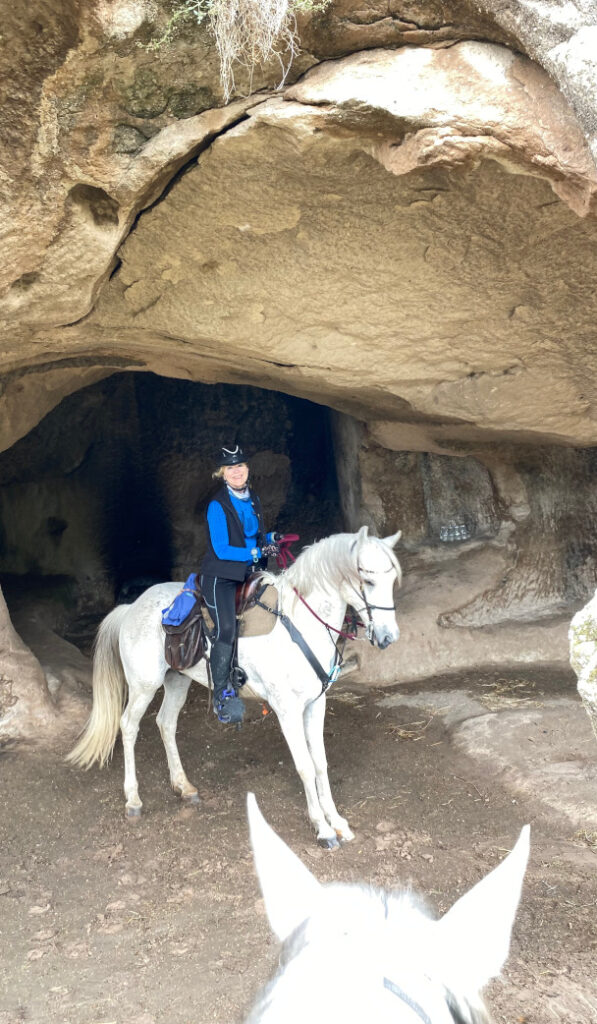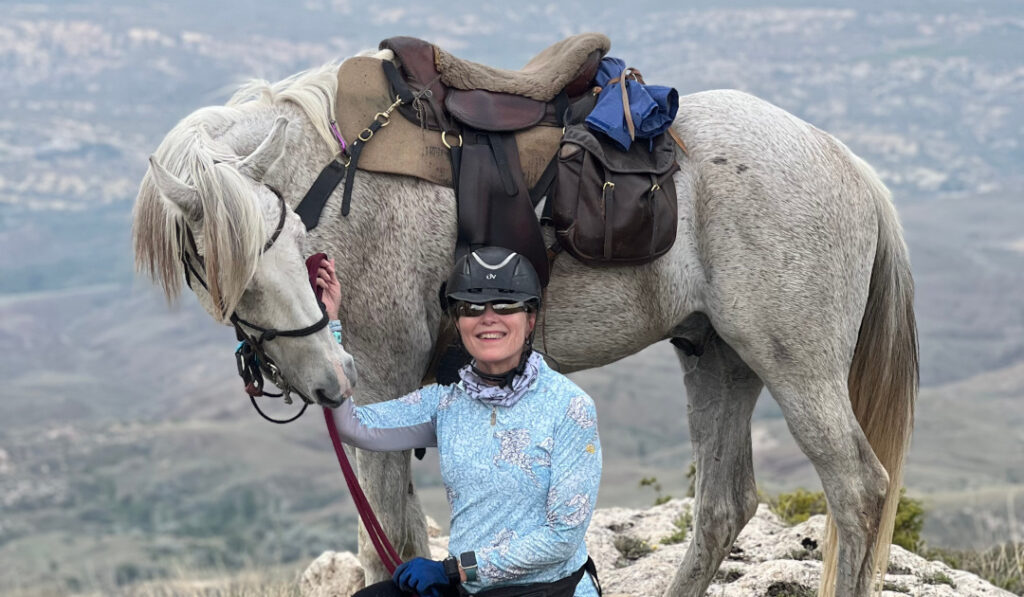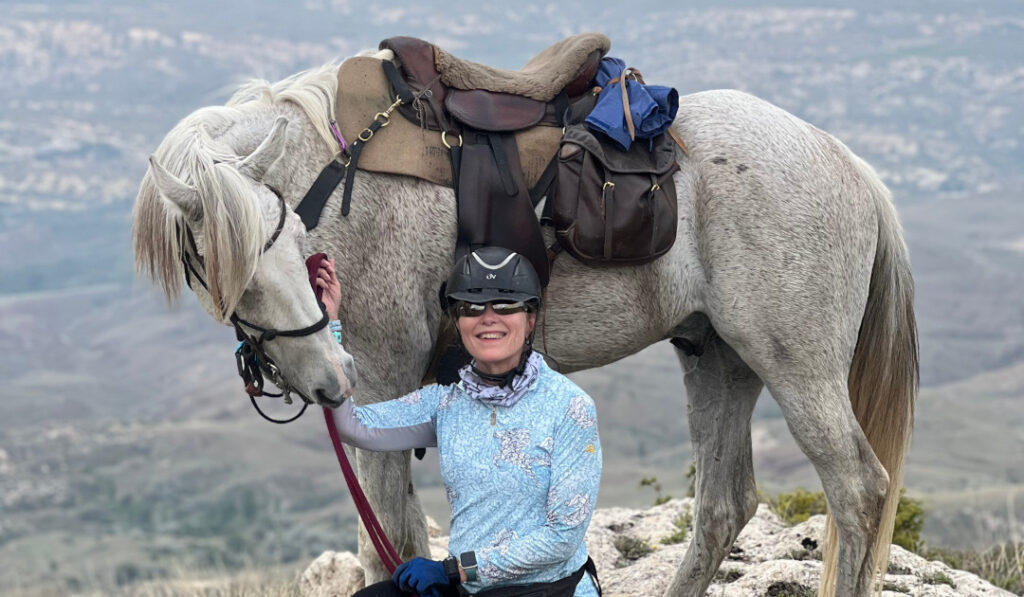After eleven horseback riding trips abroad, it never fails that I come away enriched in cultural awareness, new and deepened friendships, and business insights. This year is no different. My friends and I visited Türkiye in April when many admonished it was not a good time. Let me assure you if you are considering it, pack now! Why? Istanbul is the largest European city and serves as the bridge to the European and Asian continents. Not only are the ancient sites blended with modern diversity fascinating, but the culture is also very engaging and welcoming. While we enjoyed every minute in Istanbul, our purpose was to explore Cappadocia on horseback. It is there we were taught the value of being independent yet-together.
We were forewarned of the Frenchman who was to be our guide. He was no nonsense and required a high standard of horsemanship and physical endurance from his riders. We were to ride over 130 miles in 6 days in rugged terrain on marked and unmarked paths, dismounting to ascend and descend steep hills and mountainsides, and expected to manage exceptional mounts in a manner that considered the safety of ourselves and fellow riders. For the first time in all of the rides we have done, we sat down to a tutorial given with visual aids and props explaining to us what was expected.

Nico Guillo the owner and the manager of Kapadokya Ranch.
It was here that I first heard the phrase “Independent Riders Riding Together.” We were free to consider the horses and tack ours for the week. They were our responsibility—to care for, and to manage. We were not asked to ride single file on a marked trail as usual but to wander over ancient terrain and to explore at will as long as we didn’t get too far away. But…. when at a gallop, we were expected to stay six meters away from the horse in front of us and advised that was a good distance in general. Bad things happen when you get too close to a horse, especially at speed. And dare I say, it is usually rider error that causes the problem. The most common issue faced by all guides everywhere are people who say they have more ability than they do. Most people interpret the “ability to ride” as staying on the horse and following others. We had a young gal from the Netherlands on our ride in Jordan who had never ridden outside of an arena. Even though her riding form was excellent she couldn’t control a horse in a pack on an outdoor trail. The guide wants people who can manage their horse, and each is unique, independent of the group. That includes “defensive riding” where you do not put yourself or another in harm’s way. Although the guide’s presentation was excellent, not everyone was able to implement it with equal effect.
Why cultivate independence, in a group/team setting? Everyone is unique and has strengths and preferences. Whether it is how we ride a horse, the view we would like to see over the next rise we choose to explore, or as we know from our professional experiences, have our own ideas about how to make a product better or a sales presentation more effective, we each have ways to contribute. For most organizations, their individual people are their greatest competitive advantage and the more people in the organization who are there to add value instead of just checking off a list of duties, the more effective the organization can be and the more likely the organization is to achieve their potential. Independence can spawn creativity, insight, productivity, and so much more. It is my belief we do not encourage it enough.

Nico and Margaret looking at riding apps and trading endurance practices in their respective countries.
Why do we see so little independence in the workplace? Some organizations have policies, procedures and cultures that cater to the lowest common denominator rather than encourage the highest standard. Past success can lead to habit and creates a “way we always do things,” even if it is not as successful or relevant as it used to be. Some associates do not know what to do with the freedom to think independently. They are uncomfortable doing it or they do not know how to do it for the good of the organization. Our guide told us that even though he always empowers his riders to ride independently from the group most do not. He said he has only had one guest, a serial entrepreneur, who was not a particularly good rider, who moseyed off by himself most of the time. People do what they are taught and in 99% of horse rides, riders stick together. What intrigues me though is rather than expecting people to stick close to home, what could happen if we encourage them to broaden their thinking, to explore more new paths or ideas, and experiment with new ways of doing things? I believe, if encouraged to accomplish more, most will rise to the occasion and even if they are not able to hit the high mark without coaching, they will achieve more than they would have otherwise. After I heard about the one entrepreneurial rider, I took the message to heart and got off the main trail more often.

Margaret and Irade with the natural scenery…caves everywhere.
Another reason we inadvertently hold people back from independent contributions is because they are not educated regarding the goals of the group. For people to excel, they need to understand what is most valued and what is expected and then encouraged to contribute to it. On our ride, the group’s goals were to enjoy the ride but support the group. Safety was the number one way our guide felt you did that. Ride so your horse, you and your fellow riders do not get hurt. Taking care of your own horse, feeding, grooming, tacking, etc. meant someone else did not have to. Exploring another trail may reveal an incredible photo op that all the riders want to enjoy. Being independent has the potential to make the group’s experience better and more successful.
It is not uncommon for associates to feel communication is underwhelming and they do not know how to contribute other than perform very prescriptive processes that are listed as their duties. In your company, are people encouraged to think independently for the collective good about how to improve what they work on or how to eliminate waste that they see? With a new client we have identified three things employees would like more of in order to make a better contribution: more, better and consistent communication regarding the direction of the company or overall goals, encouragement to allocate resources differently to align with the best return, and more guidance on when to deploy various approaches so they can do a better job of matching solutions to needs.
Our guide set high standards not everyone could meet. Our first day was a “training” day. On our second day we were expected to perform as instructed. Our first canter of the day he reminded us to space out. By the second canter of the day, he brought it abruptly to a halt. He informed us we were not holding our spacing and if we could not do it individually, the team would not canter anymore. Then he turned the group around and went in a different direction bringing some select riders to the front to demonstrate what he was looking for and to coach them on how to do it. It was quick corrective action followed by mentoring to encourage those who might need it. It helped all of us understand the importance placed on this concept and gave us a visual image of what was expected. It was a good reinforcement and training experience. We never did have a pile up and people got better. While I do not think the entire group ever did meet his high standards, we came a long way collectively in a week. Raising the bar requires everyone to stretch.

A downhill descent…horse and rider teamwork. Every step matters.
Why does independence have to merge with togetherness? On a ride in Morocco, a woman in our group was celebrating her 70th birthday and her sons bought her the ride as a gift. She was joined by one of her sons on the ride. She was a good rider and certainly kept up with us all. On this ride through the Sahara Desert, we were allowed at certain stretches of terrain where the sand was not too deep, to canter or gallop. We started to canter in a two track and advised not to leave it as the deep sand on either side was not good footing. Our birthday girl was enjoying herself and took both hands off the reins to hold her arms straight out from her sides like she was flying. In her moment of exuberance, one of the more experienced but younger riders was trying to go as fast as she could and was weaving between horses and sometimes forcing them to adjust to her. Unfortunately, she cut in front of the birthday celebration and the birthday lady’s horse stepped off the two-track, rolled over on its shoulder and did a somersault and the woman riding it broke her collarbone. Independent riders? Maybe. Riding Together? Not so much. One requires the other to produce a good outcome. Clear expectations and shared goals serve as the guardrails for independent action.
There are risks that come with encouraging people to be independent but there are great rewards if that independence can be harnessed for the benefit of all. Independent Riders Riding Together. When we bring our best to a situation, take accountability for our actions and outcomes, and then contribute those benefits to a group situation, a team task, or an organizational goal, we can go further faster. For an endurance rider that is always the goal. For a business that desires to outperform competition and to increase their growth rate, they too, must encourage more individual value contribution aligned with the overall direction of the team and the company goals.
The ride was one of the most remarkable rides I have ever done. What we saw, what we experienced, the demands placed on us, and the accountability given—to be independent and yet contribute to the team—made it more than a fun experience. It made it an adventure with a goal that I can heartily say was accomplished. I left feeling I had challenged myself physically and mentally and what I learned about myself was as valued as the pleasure derived from an enjoyable and treasured experience.

Margaret and her mount for the week, Irade.

